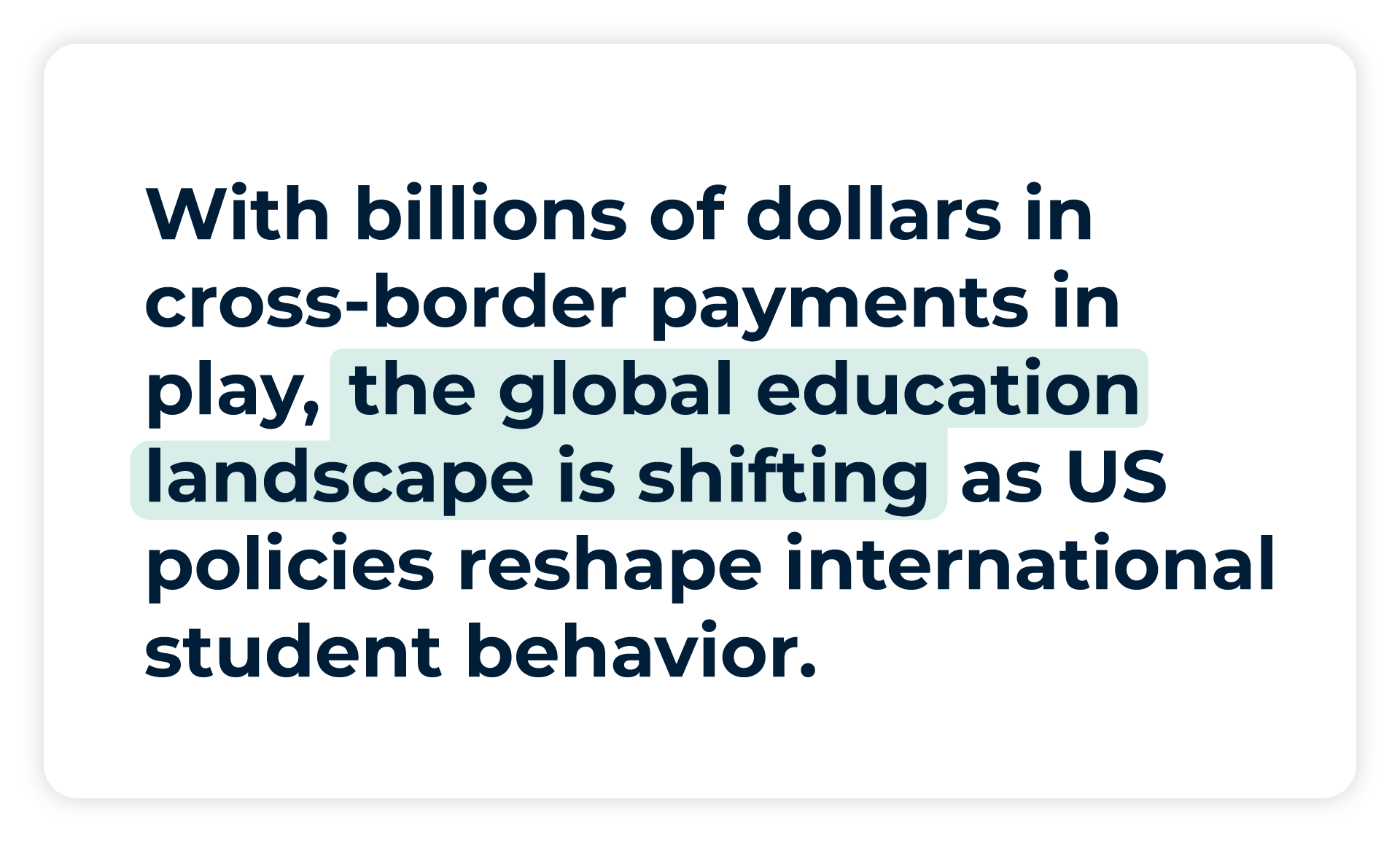International students contribute $44 billion annually to the US economy, however 13% of American universities are reporting lower postgraduate enrolment in 2025. What’s more, students are declining offers, including full-ride scholarships from elite schools, in favor of safer or more affordable alternatives in other countries.
As the Trump administration continues to create global uncertainty, students are increasingly hesitant to study in the US, and universities and colleges around the world are being pushed to rethink their internationalization strategies faster and more decisively than ever before.
In a recent Convera-sponsored webinar hosted by The PIE, higher education leaders and cross-border payment experts came together to examine how higher education institutions are responding to geopolitical uncertainty, shifting student sentiment, and the need to expand recruitment efforts into emerging markets. The conversation, moderated by Beth Kennedy, Editor of The PIE News, featured key insights from Samantha Brandauer, Associate Provost and Executive Director for the Center for Global Study and Engagement at Dickinson College, and Anil Kapur, Founder of InTandem Advisors.
The message was clear: International education is at an inflection point, and how institutions respond now may shape their global relevance for decades to come.
International students face a growing sense of anxiety
From visa restrictions and policy ambiguity to growing geopolitical tensions, students are grappling to understand if they’ll be able to return home and safely come back to their American university, whether study abroad is still feasible, and how they should plan their careers in a volatile job market. Even students preparing to visit family overseas are facing difficult choices, worried that a trip home could result in the inability to reenter the United States.
At Dickinson College, Brandauer says she’s recently seen international students withdraw from planned study abroad experiences, not because of fear about where they were going, but fear they won’t be able to return to the US to complete their degrees.
“They’re experiencing this as very chaotic and stressful, as are their families,” Brandauer explains. “We are hearing a lot of fears and anxieties and a desire to have some predictability that we just can’t promise them right now.”

How are universities responding?
While much of the focus has been on student concerns, faculty and staff who work in international education are also shouldering a heavy burden.
“For faculty and staff, there’s a lot of advocacy that we’re seeing where faculty really want to know what can we all do to help across the sector,” Brandauer says. “How can we create supportive environments? How can we think creatively about supporting students right now?”
That fatigue extends across the higher education sector. From the first days of the Trump administration, many in higher education expected changes, but few predicted how quickly and unpredictably those changes would unfold. From visa restrictions to threats of deportation, here are just challenges facing the sector:
- Over 1,000 international student visas have been revoked since early 2025, creating uncertainty and fear among families.
- Students from China, India, and Europe are reconsidering US institutions due to strained diplomatic relations and perceived hostility toward their countries.
- Concerns about campus violence and political unrest are prompting families to choose destinations with more predictable environments.
- The federal government has frozen and rescinded billions in research grants from Harvard and other universities, while governments in other countries are inviting scholars to continue their projects.
Yet despite the challenges, Brandauer maintains a hopeful outlook.
“What we’re seeing is people coming together,” Brandauer says. “This international education is already such a strong community of folks doing the advocacy work, supporting each other, listening, and thinking about innovative, creative solutions.”
Despite the challenges, education experts believe these issues will be relatively short-term and that institutions can shape their responses to shifts in US policy.
Educational institutions are looking to emerging markets
Kapur shared compelling insights on how current US policies are reshaping the behavior of students in India, which sends around 400,000 of the 1.6 million international students to the US. However, Kapur says those numbers are shifting and rapidly slowing cross-border payments.
“We are seeing about a 25-30% decline in cross-border payments into the US,” Kapur says. “The US is getting around $44 billion from foreign and international students on an annual basis. You’re talking about an $8 to $10 billion decline in these payments.”
Visa delays, tuition hikes, and uncertain job prospects are all weighing heavily on parents and students.
“They are concerned… getting student visas is a big challenge at this point… the cost of education is actually increasing as well… there are less employment opportunities,” Kapur notes. “This means that other markets are going to gain.”
Countries like Canada, the UK, Australia, New Zealand, France, and Germany are benefiting from this shift. They’re offering lower tuition costs, lower cost of living, and clearer pathways to work and residency.
Universities, specifically, are leaning into attracting international students from India, China, Southeast Asia, the Gulf countries, and others.
“They’re making a major effort in reaching out to these international students,” Kapur says. “There’s a whole lot of activity by these colleges to get out into these new-to-them markets and attract students.”
New opportunities in international education payments
Despite the sobering statistics, there are opportunities for American universities to turn this moment of crisis into an opportunity, such as setting up campuses outside the United States.
“It does help mitigate the risk that US colleges are facing right now, because the visas don’t become so much of an issue,” Kapur explains. “The cost of education is lower there, there’s more financial aid and merit scholarships provided in these branches, and I think that’s going to be a huge play in the future.”

It also means building stronger support systems on campus for international students, improving transparency in communication, and creating more flexible options for study abroad and online learning.
Resilience must be a key theme as well, Brandauer adds.
“In this sort of crisis moment, sometimes comes new thinking and innovation, and I think that I will remain optimistic that this is short-term, that we will get through this to the other side, that international education has weathered lots of things over decades and this will be one of the things that we weather,” Brandauer says.
With billions of dollars in cross-border payments in play, the global education landscape is shifting fast, as new educational markets emerge and institutions are forced to expand. With so much at stake, higher education institutions can turn to a complete international payments solution in any market: Convera provides a world-class international payments experience in over 140 currencies and more than 200 countries and territories.



